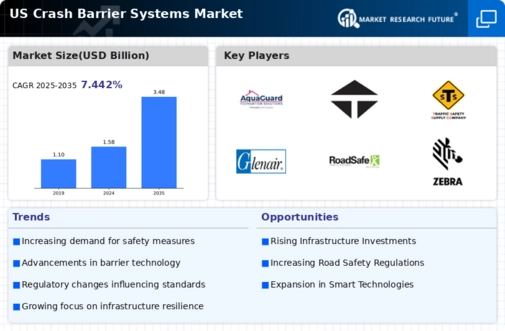Increasing Road Safety Initiatives
The crash barrier systems market is experiencing growth due to heightened road safety initiatives across the United States. Government agencies and organizations are increasingly prioritizing the implementation of safety measures to reduce traffic accidents and fatalities. In 2025, the National Highway Traffic Safety Administration reported that traffic-related deaths had decreased by 10% compared to previous years, largely attributed to improved crash barrier systems. This trend indicates a growing recognition of the importance of effective crash barriers in protecting both motorists and pedestrians. As states allocate more funding towards infrastructure improvements, the demand for advanced crash barrier systems is likely to rise, further propelling market growth. Enhanced safety regulations and public awareness campaigns are expected to drive investments in innovative barrier technologies, thereby reinforcing the crash barrier-systems market's position as a critical component of road safety strategies.
Infrastructure Development Projects
The crash barrier systems market is significantly influenced by ongoing infrastructure development projects across the United States. With the federal government committing substantial funds to enhance transportation networks, the demand for robust crash barrier systems is expected to surge. The Infrastructure Investment and Jobs Act, enacted in 2021, allocated approximately $1.2 trillion for various infrastructure improvements, including road safety enhancements. As states embark on upgrading highways, bridges, and urban roadways, the integration of advanced crash barrier systems becomes essential to ensure safety and compliance with updated regulations. This influx of investment is likely to create opportunities for manufacturers and suppliers within the crash barrier-systems market, as they respond to the increasing need for effective safety solutions in new and existing infrastructure.
Public Awareness and Education Campaigns
Public awareness and education campaigns are emerging as a crucial driver for the crash barrier-systems market. As communities become more informed about the importance of road safety, there is a growing demand for effective crash barrier systems. Initiatives led by government agencies and non-profit organizations aim to educate the public on the benefits of crash barriers in preventing accidents and saving lives. In 2025, it is anticipated that funding for such campaigns will increase by 20%, further emphasizing the need for improved safety measures. This heightened awareness is likely to influence policy decisions and encourage local governments to invest in advanced crash barrier technologies. As a result, the crash barrier-systems market may witness a surge in demand, driven by a more safety-conscious public and proactive governmental policies.
Rising Urbanization and Traffic Congestion
The crash barrier systems market is being propelled by rising urbanization and traffic congestion in major cities across the United States. As urban populations continue to grow, the demand for efficient transportation systems becomes increasingly critical. In densely populated areas, the risk of traffic accidents escalates, necessitating the installation of effective crash barriers to protect road users. According to the U.S. Census Bureau, urban areas are projected to account for over 80% of the population by 2030, intensifying the need for enhanced road safety measures. This trend suggests that municipalities will likely invest more in crash barrier systems to mitigate the risks associated with increased vehicular traffic. Consequently, the crash barrier-systems market is expected to expand as cities prioritize safety in their urban planning and infrastructure development.
Technological Innovations in Barrier Design
Technological innovations are playing a pivotal role in shaping the crash barrier-systems market. Recent advancements in materials science and engineering have led to the development of more effective and durable crash barriers. For instance, the introduction of energy-absorbing materials and smart barrier systems that can adapt to varying impact conditions is gaining traction. These innovations not only enhance the performance of crash barriers but also contribute to cost savings in maintenance and replacement. In 2025, it is estimated that the market for smart crash barrier systems could grow by 15% as municipalities seek to implement cutting-edge solutions that improve safety outcomes. The integration of technology into barrier design is likely to attract investments and drive competition among manufacturers, thereby propelling the crash barrier-systems market forward.






















Leave a Comment